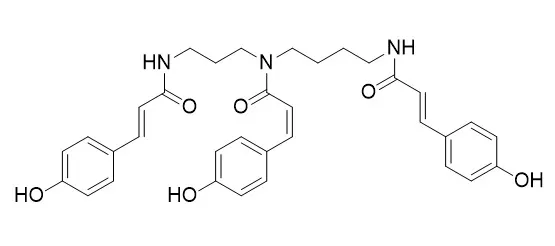| In vitro: |
| Heliyon, 2020, 6(3):e03638. | | Safflospermidines from the bee pollen of Helianthus annuus L. exhibit a higher in vitro antityrosinase activity than kojic acid.[Reference: WebLink] | Ozone deterioration in the atmosphere has become a severe problem causing overexposure of ultraviolet light, which results in humans in melanin overproduction and can lead to many diseases, such as skin cancer and melasma, as well as undesirable esthetic appearances, such as freckles and hyperpigmentation. Although many compounds inhibit melanin overproduction, some of them are cytotoxic, unstable, and can cause skin irritation. Thus, searching for new natural compounds with antityrosinase activity and less/no side effects is still required. Here, bee pollen derived from sunflower (Helianthus annuus L.) was evaluated.
METHODS AND RESULTS:
Sunflower bee pollen (SBP) was collected from Apis mellifera bees in Lopburi province, Thailand in 2017, extracted by methanol and sequentially partitioned with hexane and dichloromethane (DCM). The in vitro antityrosinase activity was evaluated using mushroom tyrosinase and the half maximal inhibitory concentration (IC50) is reported. The antioxidation activity was determined using the 2,2-diphenyl-1-picrylhydrazyl (DPPH) assay and reported as the half maximal effective concentration. Two pure compounds with antityrosinase activity were isolated by silica gel 60 column chromatography (SG60CC) and high performance liquid chromatography (HPLC), and their chemical structure deduced by Nuclear Magnetic Resonance (NMR) analysis. The DCM partitioned extract of SBP (DCMSBP) had an antityrosinase activity (IC50, 159.4 μg/mL) and was fractionated by SG60CC, providing five fractions (DCMSBP1–5). The DCMSBP5 fraction was the most active (IC50 = 18.8 μg/mL) and further fractionation by HPLC gave two active fractions, revealed by NMR analysis to be Safflospermidine A and B. Interestingly, both Safflospermidine A and B had a higher antityrosinase activity (IC50 of 13.8 and 31.8 μM, respectively) than kojic acid (IC50 of 44.0 μM). However, fraction DCMSBP5 had no significant antioxidation activity, while fractions DCMSBP1–4 showed a lower antioxidation activity than ascorbic acid.
CONCLUSIONS:
Safflospermidine A and Safflospermidine B are potential natural tyrosinase inhibitors. |
|






 Cell. 2018 Jan 11;172(1-2):249-261.e12. doi: 10.1016/j.cell.2017.12.019.IF=36.216(2019)
Cell. 2018 Jan 11;172(1-2):249-261.e12. doi: 10.1016/j.cell.2017.12.019.IF=36.216(2019) Cell Metab. 2020 Mar 3;31(3):534-548.e5. doi: 10.1016/j.cmet.2020.01.002.IF=22.415(2019)
Cell Metab. 2020 Mar 3;31(3):534-548.e5. doi: 10.1016/j.cmet.2020.01.002.IF=22.415(2019) Mol Cell. 2017 Nov 16;68(4):673-685.e6. doi: 10.1016/j.molcel.2017.10.022.IF=14.548(2019)
Mol Cell. 2017 Nov 16;68(4):673-685.e6. doi: 10.1016/j.molcel.2017.10.022.IF=14.548(2019)